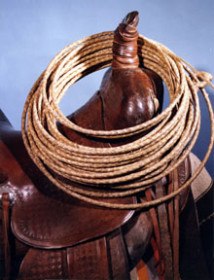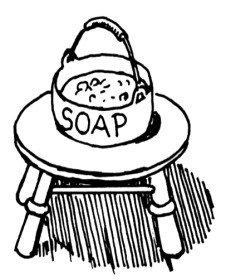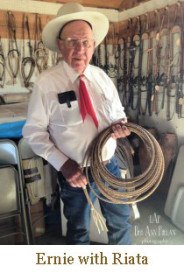Care and Treatment of Rawhide Gear
(by Ralph Pavey)
 Rawhide gear includes anything made of rawhide – reins, hackamores, bosals, romals, quirts, hobbles, reatas, etc. Rawhide is one of the oldest materials used for making horsemanship gear. It is animal skin in the same natural condition as it was when it came from the animal, with the hair removed. Gear made with good quality materials and good craftsmanship is an important part of western horsemanship. It has been said that “the quality will be remembered long after the price has been forgotten.”
Rawhide gear includes anything made of rawhide – reins, hackamores, bosals, romals, quirts, hobbles, reatas, etc. Rawhide is one of the oldest materials used for making horsemanship gear. It is animal skin in the same natural condition as it was when it came from the animal, with the hair removed. Gear made with good quality materials and good craftsmanship is an important part of western horsemanship. It has been said that “the quality will be remembered long after the price has been forgotten.”
Rawhide is different than leather. Leather is rawhide that has gone through a special “pickling” process called tanning. The tanning process changes the cellular structure of rawhide from its original natural condition. Once rawhide has been tanned it cannot be changed back to rawhide.
Rawhide gear that is given proper care and treatment can maintain its good feel and utility for many years. Care begins with the gear maker selecting quality materials, includes proper handling of the rawhide materials and craftsmanship while the gear is being made, continues with proper care during daily use and treatment after each use, and includes storage while not in use. No amount of special treatment can overcome problems caused by poor quality materials, poor craftsmanship or mistreatment.
The following cleaning and care descriptions are for rawhide gear that is truly dirty. If the gear is just a little dusty then less thorough cleaning and treatment may be in order. Too much cleaning or the wrong type of cleaning could damage the rawhide.
Sweat, dirt and manure are natural enemies of rawhide. They can get into the rawhide pores and cause discoloration and deterioration of the rawhide. Undesirable foreign matter should be promptly removed from rawhide gear after each use. A damp sponge, sheepskin swatch, soft cotton cloth or a soft brush can be used after rinsing the rawhide with clear water. Use only enough water to get the gear clean. Excessive amounts of water should be avoided. If the rawhide gets wet wipe off all excess water with a soft cloth and let it dry naturally. Rawhide gear should not be immersed in water for more than a very brief period of time because excessive moisture can distort the braiding and weaken or damage the rawhide.
A light amount of Fiebring’s saddle soap (white color) can assist with removal of undesirable materials. A small soft brush can help remove dirt where the braids cross. After removing all undesirable materials, rinse all saddle soap off with clear water and wipe off all excess water with a soft cloth. Let the rawhide gear air dry slowly. The drying process may take a little longer during periods of high humidity than during periods of low humidity. Rawhide gear will usually maintain the shape it is in while it dries, so hang it up to dry in the shape you want it to be in after it dries. Exposing wet rawhide for prolonged periods to the heat of direct sunshine, a heater, a stove or a fireplace might distort or weaken the rawhide.
help remove dirt where the braids cross. After removing all undesirable materials, rinse all saddle soap off with clear water and wipe off all excess water with a soft cloth. Let the rawhide gear air dry slowly. The drying process may take a little longer during periods of high humidity than during periods of low humidity. Rawhide gear will usually maintain the shape it is in while it dries, so hang it up to dry in the shape you want it to be in after it dries. Exposing wet rawhide for prolonged periods to the heat of direct sunshine, a heater, a stove or a fireplace might distort or weaken the rawhide.
Old time vaqueros treated their cleaned rawhide gear using the limited items they had available, usually natural animal products. Raw (uncooked) beef liver was occasionally rubbed onto the rawhide gear. Liver seals the braided work from a very small bug (mite) that can work its way into the softer middle of the braided rawhide and then eat the rawhide on the inside, making it weaker and possibly useless for a working piece of gear because it can break very easily after it is hollowed out. Liver can be rubbed on the gear by hand. Before rubbing liver on rawhide gear the blood is drained from the liver so the blood won’t penetrate and rot the rawhide strands. The liver treatment dries fast and makes the rawhide shine with an attractive appearance. The liver smell disappears when it dries. When liver was not available some of the old timers treated their gear with other natural animal products, such as raw brains or calf testicles. Many modern era rawhide braiders and gear users prefer using natural animal products rather than modern treatment products.
Several modern rawhide treatment products have been developed by saddle makers and rawhide braiders. Ray Holes Vaquero Rawhide Cream is a popular rawhide gear treatment product that can be rubbed on the gear and into the braids by hand. A little exposure warm sunshine can help the application process. After application is completed any excess product should be wiped off.
 It is best to thoroughly check out any rawhide treatment product before using to be sure it won’t damage the rawhide. Doing nothing is often better than doing something wrong. If the wrong salve, cream, or ointment is applied to rawhide it could soak into and rot the rawhide, and shorten its lifespan. Rawhide damaged by using a wrong product often cannot be revived.
It is best to thoroughly check out any rawhide treatment product before using to be sure it won’t damage the rawhide. Doing nothing is often better than doing something wrong. If the wrong salve, cream, or ointment is applied to rawhide it could soak into and rot the rawhide, and shorten its lifespan. Rawhide damaged by using a wrong product often cannot be revived.
Never use neatsfoot oil on rawhide gear. Neatsfoot oil can be used on leather, but it should never be used on rawhide because it will permanently damage the rawhide.
An occasional light application of beef tallow (kidney fat preferred) can help keep the gear soft and supple, and protect it from sweat and other moisture. Tallow should be sparingly applied by hand to rawhide gear, and only if the gear is used daily. A little exposure warm sunshine can help the application process. After application is completed any excess tallow should be wiped off. Too much tallow on unused gear may become rancid over time. Gear with tallow should be kept in the open air to keep it from getting rancid and moldy.
Leaving a mecate tied on a hackamore can create an area for sweat, dirt, mold, mildew, etc. to gather, and may distort the hackamore shape and begin the decay of the rawhide. Removing the mecate from the hackamore after each use is recommended.
When roping with a reata, do not allow a horse to step on the reata or allow the reata to get hooked on something sharp. This can cause a weak spot where the reata could break during subsequent use.
When traveling, be sure a bit or other metal item doesn’t touch rawhide or leather gear because automobile vibrations while driving can cause the iron pieces to jiggle and might damage the rawhide or leather gear it touches. A rag, piece of carpet, chaps or other similar materials put between them could prevent this type of damage.
While gear is not being used it should be stored in a safe and secure place in the open air away from temperature extremes where it cannot be chewed by horses, dogs, rats, mice, etc.
